Atlanta Breast Lift Techniques
Atlanta plastic surgeon, Dr. Mark Mitchell Jones, uses the most advanced and innovative breast lift techniques available to achieve elegant, natural results for his patients. He starts every breast lift examination by measuring the drooping of the breast. This is judged by how far the nipple has fallen in relation to the base of the breast, or the inframammary fold (IMF). IMF is the fold at the bottom of the breast, where the chest and the breast converge. A young woman with no history of pregnancy or breastfeeding should have a nipple located slightly above the IMF. This generic shape is referred to as “a normal breast posture” (Figure 1). In first degree ptosis (sagging), the breast droops mildly (Figure 2). The nipple is located just at the IMF. With second degree ptosis, breast sagging is moderate; the nipple rests just below the IMF (Figure 3). In the case of third degree ptosis, sagging is advanced and the nipple sits significantly below the IMF (Figure 4).
 |
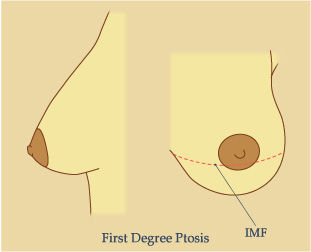 |
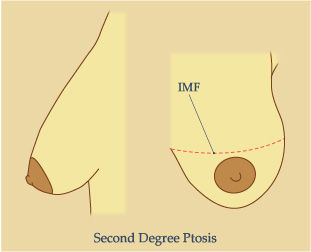 |
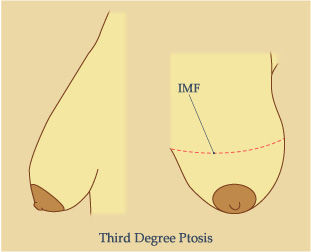 |
Approach Options in Breast Lift
There are various ways a surgeon can address these problems. Increasing the amount of breast tissue with a breast implant is one approach. However, this increases the size of the breast, as opposed to simply lifting its angle.
The second option is to remove a section of skin, thus making the ‘container’ for the tissue smaller. This approach does not change the volume of the breast, but just the way tissue is held in place. Naturally, the amount of skin removed relates directly to consequential scarring.
The third alternative is to combine the two techniques—adding a breast implant and removing skin. For safety reasons, a breast implant must be placed under the muscle when skin is being removed or tightened at the same time. This stipulation results in less scarring because adding the breast implant allows the surgeon to remove less skin than without the implant. In many cases, this combination results in the most natural looking and feeling breasts.
It is usually Dr. Jones’ recommendation that women stage the two procedures. First, he completes the breast augmentation with the implant and then allows healing for six weeks prior to fine-tuning the results by excising any unnecessary skin. This separation of procedures allows for much more predictable results and demands less scarring.
Best Breast Lift Options
When looking at the different breast lift options available, Dr. Jones will determine the best type of excision to use to minimize scarring.
Types of Skin Excisions
All skin excisions will result in some scarring. In a small breast lift, alternatively called a Benelli breast lift, scarring is minimal. The problem is that it only works with small breasts. A Benelli breast lift involves excising a doughnut shaped area around the darker skin of the areola and the nipple (Figure 5), resulting in a nearly invisible scar around the areola. Using the Stanford stitch and the Paris trick, Dr. Jones’ suture leaves a nearly invisible scar. Stanford stitching is a special way to close the incision so that the width of the scar is minimized. Dr. Jones learned this technique while he was a resident at Stanford University. The Paris trick was picked up in Paris, and allows him to remove the stitches easily and painlessly.
 |
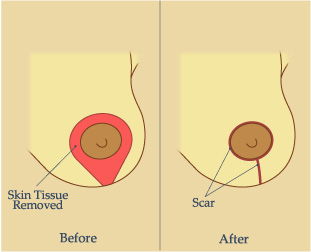 |
In a medium breast lift, also called dufourmentel breast lift, the skin excised is an ice-cream cone shaped area around the areola and the bottom side of the breast (Figure 6). The skin removed from below the areola on a horizontal plane eliminates some of the stretched skin and helps create the lift.
In a large breast lift, also called an anchor lift, a significant amount of skin is removed from around the areola and the bottom and side areas of the breast. The name anchor lift comes from the resulting shape of the scarring (Figure 7). The scarring is considerable because so much stretched skin has to be removed. This approach is applied when the patient has advanced level of droopiness. It is also commonly performed in a breast reduction. Though the scars in the anchor lift are the most noteworthy of all breast lifts, the lifting is also substantial.
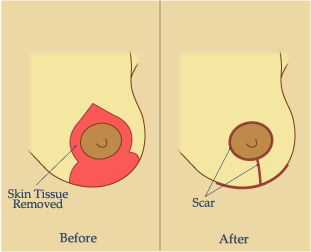 |
A Few Words about Scarring
Because scarring is inevitable in any breast lift, Dr. Jones will provide you with open communication every step of the way, letting you make the choices. Most procedures are designed to leave scarring discreetly at or below the nipple level. Although no surgeon can predict the final appearance with 100% certainty, Dr. Jones is honest and upfront about the risks, limitations, and benefits of every procedure he performs.
If you would like to schedule a breast lift consultation with Dr. Jones, please contact our Atlanta Breast Lift Techniques Specialists today.